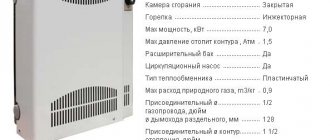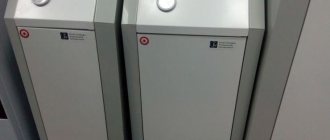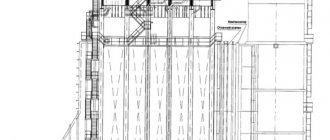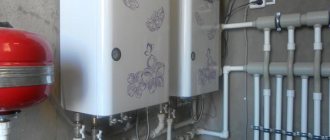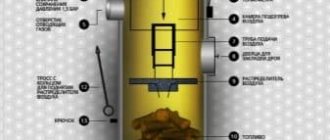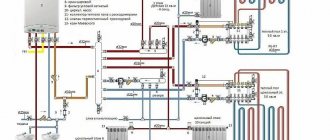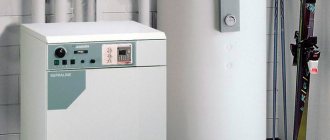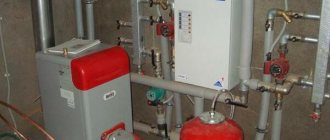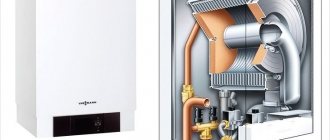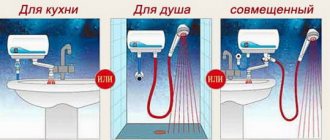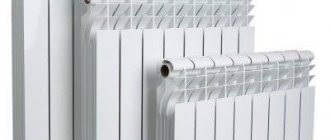Home ⋙ Solid fuel boilers ⋙
Solid fuel boilers are a very relevant topic today, especially in areas far from electricity and gas pipelines. The variety of boilers differs only in the fuel used and combustion technology. Solid fuel gas generator boilers are those boilers that use a rather innovative principle of solid fuel combustion - pyrolysis. How does such a device differ from similar ones that operate on the principle of combustion of wood, coal and other types of solid fuel?
Rice. 1 Solid fuel gas generator boiler
Principle of operation
A solid fuel gas generator boiler differs from others in its combustion principle. Most likely, this cannot even be called combustion - it is pyrolysis or smoldering.
By design, the boiler has two combustion chambers:
- In the first, the pyrolysis process occurs, that is, the smoldering of coal with a small amount of incoming oxygen. As a result, there is a slow decomposition of solid fuel into resins, steam, oils and carbon - pyrolysis. This releases flammable gas.
- In the second, the gas begins to burn intensively, with the supply of oxygen from the air and produces additional heat, increasing the efficiency.
It turns out that in a solid fuel gas generator boiler two types of fuel are used simultaneously in parallel. Actually, solid fuel, which smolders, releases heat and flammable gas, which is released during the pyrolysis process. This type of solid fuel gas generator boilers combines gas and solid fuel boilers.
The principle of operation of a wood-fired gas generator boiler
When operating a wood-fired gas generator boiler, the principle of pyrolysis . After adding fuel (firewood or special wood briquettes), they go through several stages of combustion. Let's look at them:
- Initially, wood fuel enters a special chamber where it is dried.
- The wood fuel is then burned while maintaining a temperature between 20 and 850 degrees Celsius. In this case, practically no oxygen enters the combustion chamber. Thus, the oxidation of wood fuel occurs,
- The gas resulting from oxidation enters the combustion chamber, where it is ignited and burned using burners.
Gas-fired wood-fired boilers used for heating purposes have a special water circuit. Inside it, the water passes through two heating chambers, and only then enters the heating radiators.
Fuel
For proper operation of a solid fuel gas generator boiler, fuel that meets certain characteristics is required. It must contain a large amount of light substances, not be too wet (no more than 20-30%), and water vapor should not interfere with decay.
The types of fuel listed below are suitable for pyrolysis boilers:
- Wood or simply firewood of a size suitable for loading into the device.
- Wood shavings and waste from the woodworking industry.
- Specially compressed biofuel briquettes - pellets.
- Compressed wood dust - fuel briquettes.
- Coal production products include coke and hard coal.
- Brown coal is also good for use.
As you can see, the variety of solid fuels for solid fuel gas generator boilers is large. This makes their use widely available in many areas of residence.
Rules for choosing fuel
During the combustion of any solid fuel, carbon monoxide is released. From the experience of using gas generators, it has been proven that the release of this gas in especially large quantities occurs when wood is burned.
Hence the conclusion that it is best to heat this unit with wood . In modern boilers, their ignition and further combustion process are fully automated. At the same time, certain requirements are imposed on such fuel.
The moisture content of the wood used should not exceed 20%, otherwise it will have to be pre-dried. At the same time, you should choose only the hardest types of wood: beech, oak, acacia. You cannot use coal in those models where this option is not provided, as the unit may fail.
Advantages
In addition to the variety of applications of different types of fuel, the geography of application of gas-generating boilers using solid fuel is also wide.
Among other advantages:
- Autonomy, independence from any gas pipelines or power lines.
- There is an automation that supports the pyrolysis process by opening and closing the dampers, depending on the temperature (there is a thermostatic sensor).
- It is possible to regulate the degree of heating of a solid fuel gas generator boiler by adjusting the draft.
- No soot is formed on the walls of the apparatus.
- Less emissions of harmful substances into the atmosphere during pyrolysis.
- Low cost of coal or firewood compared to electricity and gas.
- Overheating protection – presence of a protective cooling circuit.
- Economical with an efficiency of 85%.
Taking into account the listed significant advantages, we can say that buying solid fuel gas generator boilers is a good purchase. But there is no technology that is completely free of some shortcomings, and a solid fuel gas generator boiler is not without them.
Advantages of pyrolysis boilers
The complexity of the design of gas generator boilers affected their cost. Therefore, before purchasing, you need to weigh the pros and cons of such heating systems. The main advantage of pyrolysis boilers is a long operating time on one load of firewood. On average, it lasts for 10-12 hours with normal operation and 5-6 with intensive operation. Such efficiency has a positive effect on reducing current heating costs.
In addition, the following advantages can be noted:
- High efficiency rate. The firewood burns out completely, its energy is used for auxiliary heating of the heat exchanger, and the flammable gases perform the main function of heat transfer.
- Small amount of combustion products. They practically do not settle on the walls of the chimney, which does not lead to a decrease in its useful diameter and does not affect draft.
- Automatic operation of the heating system. If there is an automation unit, boiler maintenance is carried out only twice a day.
A relative disadvantage is the low temperature of carbon monoxide entering the chimney. The difference between the heating of the pipe and the outside air causes condensation. Moisture enters the main combustion chamber and negatively affects the efficiency of the system.
To solve this problem, you need to install insulated chimneys. They consist of a coaxial pipe, in the walls of which basalt wool is located. You can do it yourself, but it is better to use factory models.
Flaws
- The main disadvantage can be considered the high cost of a solid fuel gas generator boiler, but you need to remember that operation and maintenance are cheap, and you will be buying a boiler for many years.
- Increased requirements for quality and, especially, fuel moisture.
- To remove burnt substances after pyrolysis, smoke removal is required. This means that the use of solid fuel gas generator boilers is possible only in houses where it is possible to vent the pipe into the atmosphere, without causing inconvenience to neighbors. Therefore, it is hardly applicable in high-rise buildings.
- Some limitation in temperature conditions. To prevent condensation from forming, the temperature of the water coming from the heating system should be about 60 degrees.
- It is impossible to automate the supply of solid fuel to the furnace.
- High requirements for the tightness of solid fuel gas generator boilers. Leakage of flammable gas may cause an explosion or fire.
However, some disadvantages of boilers operating on the principle of pyrolysis are also inherent in some boilers that use coal, gas or wood as fuel. The ratio of advantages and disadvantages speaks in favor of solid fuel gas generator boilers.
Fuel for gas generator boilers
The undoubted advantage of gas generator boilers is the fact that they can operate on almost any type of solid fuel. That is, they can be filled with ordinary chopped firewood, as well as any type of wood waste (sawdust, shavings) and briquettes, pellets, etc. made from wood waste. In addition, gas generating plants are practically waste-free production: the fuel in them burns with virtually no residues.
Gas generator boiler
Advantages of heating gas generating units
Installation of heating systems powered by gas generator boilers running on wood fuel has the following undoubted advantages:
- Extremely high combustion efficiency. In any installation designed to burn wood fuel, but not using the effect of pyrolysis, the efficiency cannot rise above 90 percent.
- Gas generating units are non-volatile and can be installed even in buildings that do not have a connection to a stationary power grid. Note that during the war, gas generator units were even placed on cars. The energy independence of the gas generating unit also reduces the cost of its operation.
- Almost any type of wood fuel can be used in a gas generator installation, from classic firewood to wood waste. The use of wood waste, sawdust, wood chips, and so on significantly reduces the cost of operating gas generator systems. However, remember that of the total volume of fuel supplied at a time, the percentage of wood waste should not exceed 30 percent.
- Large volumes of the combustion chamber allow gas-generating boilers to operate for a long time on one load of fuel, which facilitates the operation of such an installation.
gas generator boiler device
Disadvantages of gas generating plants
Despite all the attractiveness of heating and heating systems based on gas generators, such devices also have certain disadvantages. The disadvantages of gas generator systems generally coincide with the disadvantages of conventional solid fuel boilers.
A solid fuel boiler, unlike automated liquid or gas systems, has limited operating autonomy. Such a boiler always requires a human operator who will add fuel as it burns. Also, the gas generator boiler must be regularly maintained and cleaned of soot and soot. Despite the almost complete combustion of organic wood fuel in gas-generating boilers, decomposition products are still present in such systems.
gas generating unit
Purchasing a system with a gas generator boiler is quite expensive financially. According to rough estimates, a gas generator boiler will cost you one and a half times more than a conventional solid fuel boiler. But the difference in cost should pay off after several heating seasons, based on the higher efficiency of the gas generator boiler.
Also, when operating gas generating units, it is necessary to use only dry fuel. On wet wood or sawdust, the pyrolysis process may simply not start. Therefore, gas generator boilers are often equipped with a drying chamber in which the fuel reaches the desired condition.
Design
The gas-generating pyrolysis boiler has two combustion chambers. The first serves as a gas generator, where smoldering wood or coal emits flammable CO gas. In the second, gas is burned. This uses energy from both chambers. Since gas combustion is easier to control, automatic dampers are used to regulate the flow of gas after pyrolysis and oxygen from the air. This makes it possible to regulate the combustion temperature and energy transfer to the coolant within a wide range.
Rice. 2 Solid fuel gas generator boiler
DEVICE AND PRINCIPLE OF OPERATION
Gas-generating furnaces with supercharging heat output from 10 to 150 kW are designed according to a scheme with a lower afterburning chamber of pyrolysis gas, which is pumped into it by a special fan from the fuel compartment located above. After ignition, air is supplied to the firewood in such a way as to maintain a deficiency of oxygen, leading to incomplete combustion and the formation of pyrolysis gas.
The gas and solid particles burned in the lower chamber form a high-temperature mixture, which, passing through a vertical heat exchanger, transfers heat to the coolant (water), after which it is discharged into the chimney. Additional heat transfer, facilitating more efficient use of the calorific properties of the fuel, occurs in a cast-iron water-filled grate. The heated water is removed from the boiler through the upper pipe and, after passing through the heating network, returns through the lower one.
The combustion intensity is determined by the operation of the boost fan. By controlling the air supply, you can regulate the boiler power and, accordingly, the room temperature. For this purpose, the boilers are equipped with a system that controls the air supply based on signals from sensors that respond to the degree of heating of the coolant. With its help, you can set and maintain the required temperature in the house. If the fuel burns out completely, the system will automatically turn off the unit.
Installation
Special requirements for the installation of a solid fuel gas generator boiler:
- It must be installed by professionals licensed to install this equipment. This is due to the specifics of pyrolysis boilers, where certain safety rules must be taken into account.
- The pyrolysis boiler must be installed in a separate room (for example, on the ground floor). The room where the solid fuel gas generator boiler will be installed must be lined with refractory bricks.
- It is not allowed to store solid fuels or flammable materials indoors or near the pyrolysis boiler.
- The equipment is mounted on a concrete foundation and must stand firmly on it.
By entrusting the installation of the boiler to specialists, you will be confident in the correct and efficient operation of the equipment for many years. Don't take risks and neglect the safety of your home.
Rice. 3 Solid fuel boiler Atmos
Self-installation
To install a solid fuel boiler yourself, you need to take into account several rules.
- It is better to place such a boiler in a separate room. This could be a room inside the house or in the basement. A former children's bedroom or any other small room (required area - 8-10 square meters) is suitable for this, if a special room for heating devices is not allocated during construction. As a last resort, you can simply partition a large room in half (it is advisable to make the partition brick, rather than using drywall), making one or two exits - inside the room, outside, or both at once.
- The floor of the room where installation is planned must be made of fire-resistant materials. And the boiler itself should be installed directly on a concrete screed (about 10 cm thick).
- It is necessary to provide the premises with forced ventilation, power and water supply if they are not available.
- If the boiler is not installed in a specially designed boiler room, you should purchase and install a chimney in advance.
When starting installation, you need to prepare the tools and equipment that will be needed for this: electrodes, welding, level, keys, screwdrivers, meter, metal saw, screws, as well as materials: plumber’s tape, sheet of metal and sealant.
- Unpack and prepare for assembly the parts included with the boiler.
- Place the metal sheet on the floor at a distance of at least 0.5 m from the side wall(s) and 1 meter from the front and securely fix it.
- Place the boiler level on a metal sheet, checking the correctness of the level.
After the preparatory work, the boiler itself is assembled:
- Wrap the combustion regulator with one turn of plumbing tape, secure it with a screw, and set the temperature to 30 degrees.
- Install the thermostat and heater or their plugs.
- Assemble the air and safety valves, pressure gauge into a safety group.
- Install the faucet and connect it to the pipes.
- Connect the safety group in front of the locking device.
- Connect the boiler to the chimney using sealant.
- Push in the draft flap and the cleaning plug.
- Connect the water and check the system for leaks.
- Light the boiler by closing the damper.
- All that remains is to check the quality of installation and operation of the boiler and carry out pilot heating.
In order to determine the approximate cost of materials and equipment required for installation, their estimated price is given below.
- Heat-resistant sealant 100–200 rub.
- Sheet of metal (3 x 1,250 x 250) about 3,000 rubles.
- Plumbing tape about 500 rubles.
- Long-burning boilers RUB 60,000–120,000.
- Steel transition 57–32 30 rub.
- Steel bend Du-5016 from 100 rub.
- Ball valve Du-15 from 100 to 1,000 rubles.
- Ball valve with duct DU-50 about 2,000 rubles.
- Chimney for a solid fuel boiler RUB 20,000–50,000.
The choice of heating boilers should be based on the availability of a particular type of fuel in the region or its presence in the house. Heating with solid fuel boilers using firewood is second in cost only to gas-powered devices; electricity and diesel fuel are more expensive, and coal-based units come in last. This is not least due to the fact that solid fuel boilers have insufficiently high efficiency indicators (compared to electric ones, for example). However, two-level combustion systems can save fuel consumption by up to 9%.
The most environmentally friendly heating devices among solid fuels are pyrolysis gas generator boilers, since the fuel they use burns almost completely, which reduces the level of air pollution.
The video shows how gas generator boilers work:
Story
When developing solid fuel gas generator boilers, attention was primarily paid to the volume of the combustion chambers and the amount of solid fuel consumed. But because of this, they achieved a slight increase in efficiency with increasing overall dimensions and weight of the boilers. No one took into account that pyrolysis releases gas, which was not effectively used in the chambers of previous models of wood or coal boilers.
As a result of lengthy experiments, it became clear that it was necessary to use the properties of organic substances, which, when there is a lack of oxygen, release flammable gas - pyrolysis. The use of solid fuel not for the main release of heat, but for the production of CO, made it possible to create a boiler that combines the combustion of solid fuel and gas. The solid fuel gas generator boiler increased the heating effect, combined savings and low cost of fuel, using the pyrolysis process.
Boiler efficiency comparison
When comparing the presented types of boilers, which not only heat the room (heat the coolant), but also generate electricity by using the generated heat, you should pay attention to important aspects during operation.
Both the NAVIEN company and the Viessmann company position their boilers, pointing out the undoubted advantages - complete automation of the process, no need for service repairs and generally a complete lack of intervention after commissioning by the buyer.
For the operation of these boilers, all that is needed is stable operation of the system and stable availability of gas (whether it be main supplies, a bottled installation with liquefied gas or a gas holder). Accordingly, domestic gas is used to operate boilers, which after combustion does not pose any harm to the environment.
In principle, almost the same can be said about the Indigirka heating stove, only the type of fuel here is not gas, but firewood, pellets or pressed sawdust.
Complete absence of automation, which requires electricity. The electrical energy generation system and the boiler itself do not affect each other’s operation, i.e. If the electricity production system fails, the boiler continues to perform its functions.
All of these gas-processing heating units, with Stirling engines located under the burners, produce electrical energy that can be used for various purposes
Boilers from NAVIEN and Viessmann cannot boast of this, since the Stirling engine is built directly into the boiler design. But how profitable are such systems and how long will it take for such a boiler to pay for itself? This issue is worth understanding in detail.
